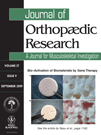Anatomic variations between Japanese and Caucasian populations in the healthy young adult knee joint
Abstract
Our objective was to characterize variations in mechanical knee alignment, tibial torsion, tibial width, and ACL laxity measurements between Japanese and Caucasian populations in the healthy, young adult knee joint. Seventy young adult subjects participated in this study, including 23 Japanese and 47 Caucasian subjects. Coronal magnetic resonance images of the hip, knee, and ankle were acquired for analysis. Japanese subjects had a significantly higher (p = 0.04) varus alignment (1.64 ± 0.43° standard error) than Caucasians (0.55 ± 0.33°), while women exhibited a more valgus alignment (0.16 ± 0.52°) than men (0.94 ± 0.42°, p = 0.04). Significant differences were found in tibial torsion and ACL laxity (p < 0.01) between ethnicities, with Japanese exhibiting lower tibial torsion (33.4 ± 10.0°) and higher ACL laxity (7.5 ± 0.4 mm) measurements compared to Caucasians (38.9 ± 9.5° and 5.7 ± 0.3 mm, respectively). Significant differences between genders were found in hip-knee-ankle alignment (p = 0.04), tibial width (p < 0.0001), and ACL laxity (p < 0.01) measurements. Measurements were reliable between observers and for repeated positioning. Our study provides new insight into anatomical and geometric differences in the knee joint between Japanese and Caucasians, as well as between females and males. Further consideration of these results may improve development of implants to accommodate for these differences, and understanding of characteristics leading to increased prevalence of knee OA in certain populations. The use of magnetic resonance imaging to obtain these measurements also allows soft tissue structure characterization without exposure to ionizing radiation. © 2009 Orthopaedic Research Society. Published by Wiley Periodicals, Inc. J Orthop Res




